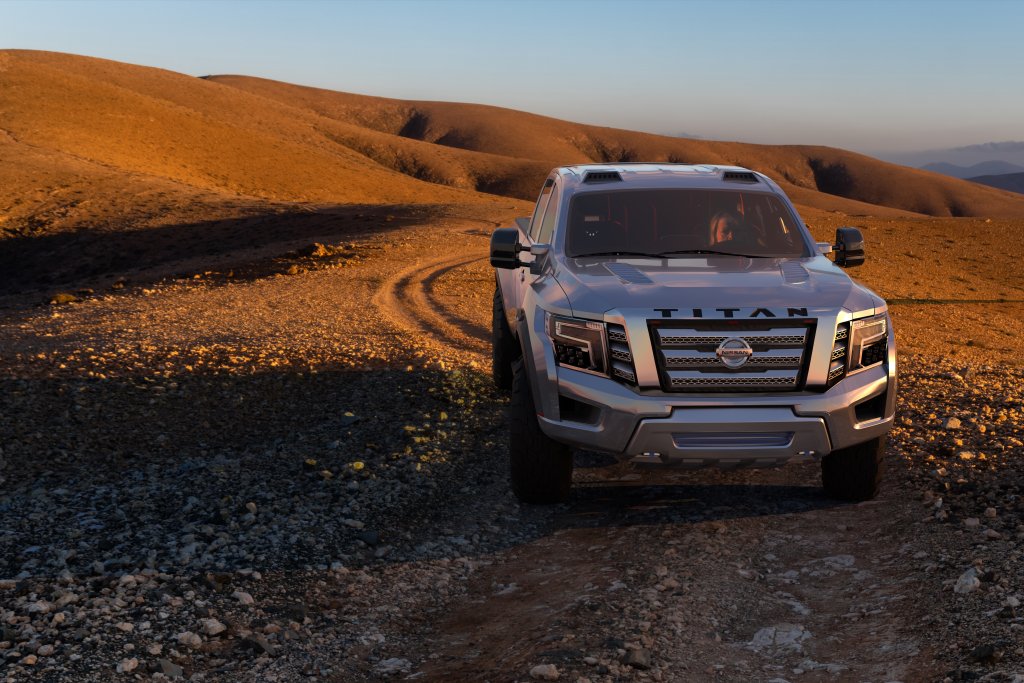Named after the mythological Titans from Ancient Greek History, the Nissan Titan was produced in 2003 as a 2004 model year. The Japanese automaker introduced it to compete directly with half-ton trucks from the likes of Ford, GM, Toyota, and Dodge. Originally built with a 5.6-liter V8 engine that produced 317 horsepower, the Titan came with rear-wheel or four-wheel drive and was offered as a king or crew cab truck.
The Titan has been known for its towing capacity, sleek styling, advanced technology, and family-friendly interior. While Nissan’s full-size pickup improved throughout its life, we recommend avoiding specific years. We categorized the Titan into its best and worst years and arranged important information in the following table. After explaining sources and data, we completely break down each model year’s strengths and weaknesses.
Nissan Titan Engine Reliability Score, Safety Ratings, MPG, and Value v.s. Maintenance & Repair Costs – Year by Year
Our first and crucial determinator for each Titan’s rank as the best or worst is the Nissan Titan Reliability Score. The first table portrays reliability and displays two scores, FIXD, and Owner Reliability. The FIXD Reliability Score is an objective score produced by data from FIXD devices installed in Nissan Titans. The subjective Owner Reliability Score is derived from answers to owner surveys.
After analyzing the reliability of each year of the Titan, we dive into multiple other sources to complete the ranking. Our next factors considered are the safety rating from the National Highway Traffic Safety Administration (NHTSA), the miles per gallon from fueleconomy.gov, and the current market value of all Nissan Titans from Kelley Blue Book (KBB). We merge the final graph with the average annual repair and maintenance costs, provided by owners’ answers to the question, “How much would you say you spent on repairs and maintenance in 2022?”
After thoroughly examining each visual representation of our sources, we will plunge into the best and worst years of the Nissan Titan. We include essential features, major diagnostic trouble codes, and details about safety recalls.
If you’re in the market for a car, take a look at our article on the USA’s most reliable and cheapest to repair cars in the U.S. Don’t get stuck with a lemon, use our data to help you shop.
Engine Reliability Score – Over The Years
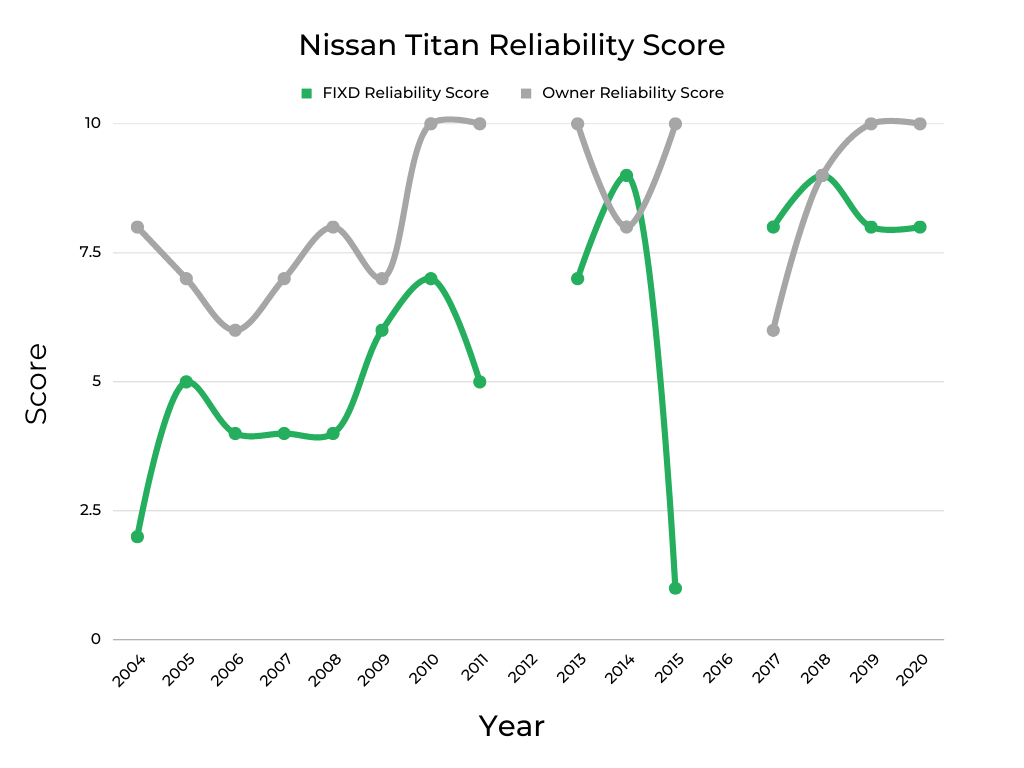
The Nissan Titan’s best and worst years ranking was predominantly influenced by reliability. We’ve devised two unique scores using our exclusive data, making it easy to compare. Both scores use the same scale: 1 is the worst, 5 is the average, and 10 is the best rating.
The first score is the FIXD Reliability Score, represented by the green line on the graph. We calculated this score by tracking the number of check engine lights (CEL) reported by our app users and dividing it by the number of cars. We then weighted the score based on an average of 12,000 miles driven annually.
While we examine recurring DTCs in each model year of the Titan, you can find more information in our article about the most common Nissan diagnostic trouble codes.
The second score, the Owner Reliability Score (gray line), comes from surveys taken by Nissan Pathfinder owners. These surveys capture their firsthand experience and provide subjective opinions on reliability. We translated these responses into numerical scores. For more details on the question asked and our methodology for determining this score, please refer to the note about data and information section located at the bottom of this article.
A typical reliability graph shows newer model years with higher reliability than older ones. This is mostly true for the Nissan Titan. However, 2015 stands out as a year where the FIXD Reliability Score is significantly lower than the previous year, while the Owner Reliability Score stays at a perfect 10/10.
Owner Reliability Scores are generally higher than the FIXD Reliability Score. Owner Reliability is only lower than FIXD Reliability in the 2014 and 2017 model years of the Nissan Titan. A lower Owner Reliability Score might indicate issues with items unrelated to the engine since the FIXD device only reports engine-related diagnostic trouble codes. The Owner Reliability Score stays above average in the Titan, even amongst years we suggest avoiding, such as 2004-2008.
A car’s reliability is often worse than an owner might want to believe. We hypothesize that owners of older models slowly become accepting of higher-than-average check engine lights being thrown because they have owned the car for a long time. They are either a frog in a pot of boiling water, not realizing the car is deteriorating slowly and getting worse. OR they simply haven’t compared the reliability of their older model to the often newer and more reliable models of today.
Loyalty to an older vehicle may also affect the Owner Reliability Scores. If a car has lasted 20 years, it would be immensely reliable in the owner’s eyes, even if it had to have repairs and triggered many CELs along the way.
Another common trend in most vehicles is the first year of a new generation getting a low-reliability score. The trend could be due to new technology and enhancements causing new problems. This isn’t seen in the Nissan Titan, as it has only been produced for two generations. However, the first year of the truck (2004) is a model year we recommend evading. On the other hand, the beginning of the second generation (2017) is one of the most reliable years of the Titan.
We don’t have any data for the 2012 Nissan Titan and only a small amount for 2020. Therefore, these two years are left out of our analysis of the Nissan Titan. Nissan did not produce a Titan in 2016.
NHTSA Safety Score – Over The Years

Using published NHTSA data, we graphed the safety rating of the Nissan Titan (green line) against the average safety rating of the auto industry (gray line). The Titan underperforms the industry almost yearly, scoring above average in 2005 and 2017.
The best safety rating in the Titan is seen in 2017 when it was rated 4.8 out of 5 stars. The worst rating was 3/5 in both 2011 and 2014. The safety rating stays around 4/5 in most years, only above that score in 2005 and 2017-2019. In comparison, the Chevrolet Silverado scores 4.5 or higher every year after 2009.
Safety ratings are important, especially since the most common use for the Nissan Titan is as a family vehicle (32% of owners). Higher safety ratings can also help you get cheaper car insurance.
If you live in one of the states listed below, we can show you the cheapest vehicles to insure in yours.
| What Used Cars Are the Cheapest To Insure In: |
| Ohio |
| North Carolina |
| Michigan |
| Georgia |
| Texas |
| New York |
| Illinois |
| Pennsylvania |
| California |
MPG – Over The Years
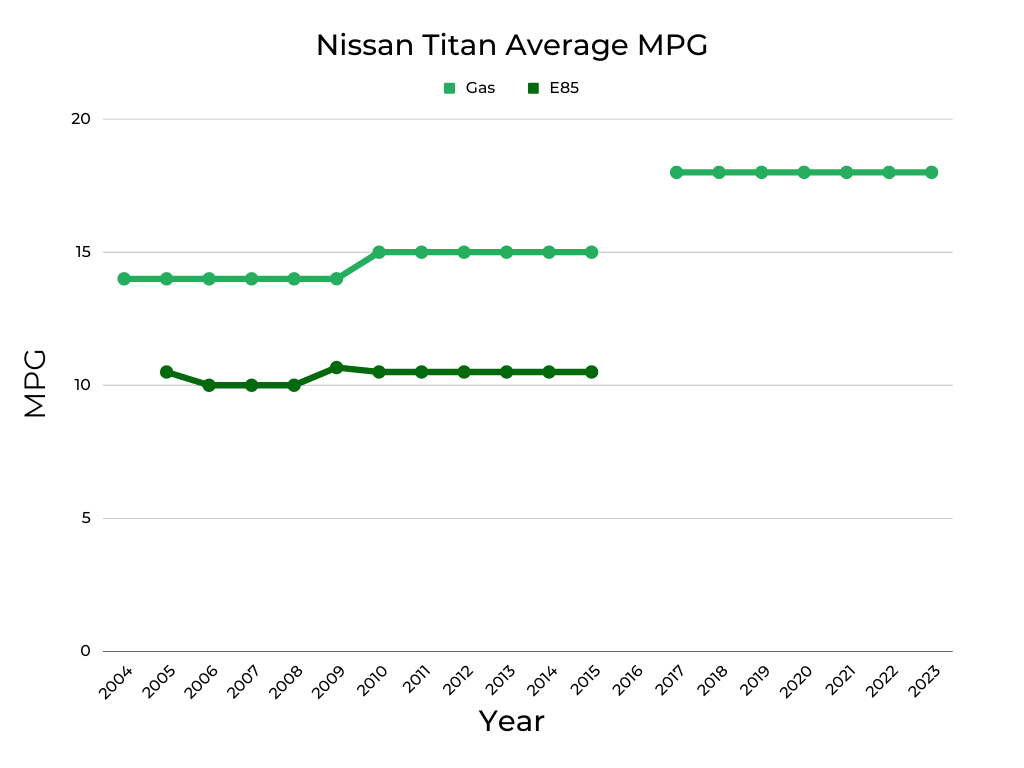
Full-size trucks aren’t known as fuel-efficient vehicles. Many are bought based on their towing capacity or off-road capabilities before miles per gallon are ever considered. The green line in the graph above shows the average miles per gallon of all trims of the Nissan Titan.
The Titan’s fuel efficiency is consistent, staying at 14-15 mpg throughout the entire first generation (2004-2015). After a hiatus in 2016, the all-new 2017 Nissan Titan improved its V8 engine with Direct Injection Gas (DIG) technology, boosting it to an average of 18 mpg.
You shouldn’t compare the fuel efficiency of the Titan to a sedan, but across other makes and models, it stacks up well. The Toyota Tundra’s best miles per gallon is only 16, achieved in 2005-2006 and again in 2010-2016.
Current Market Value of All Nissan Titan Years & Cost Per Year to Repair and Maintain Each
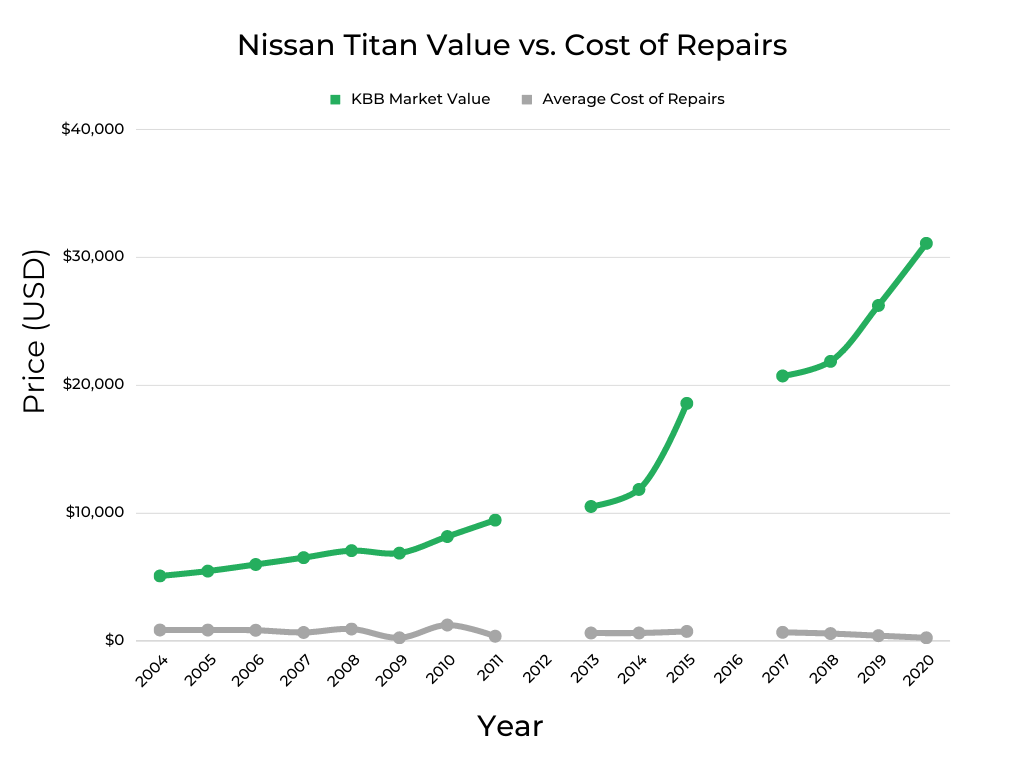
The graph above shows the current market value of the Nissan Titan according to KBB.com as a green line. A gray line shows the annual cost of maintenance and repair.
As expected, newer years have a higher market value, with a used 2020 Nissan Titan worth an average of $31,079. One exception is in 2009, where the value is less than the older 2008 model. This is because the average reported miles for 2009 is higher at 175,000 than for 2008 at 150,000. High mileage inversely affects the value of a vehicle.
Average repair and maintenance costs are relatively low for the Nissan Titan, at only $701 per year. However, owners of the 2010 Titan reported the highest ownership costs of $1,250. The lowest repair costs are seen in 2009 and 2020, where it is only $250 annually.
When shopping for a used Nissan Titan, it’s important to keep in mind that not all vehicles are cared for equally. To protect yourself from lemons, take along a FIXD Sensor on your test drive. FIXD connects to a free app on your smartphone to tell you more about the vehicle you’re checking out, including check engine lights and other hidden issues that the owner or dealership may be attempting to hide. Click here to learn more and get FIXD for only $19.99 (regular price $59)!
Important Features Timeline
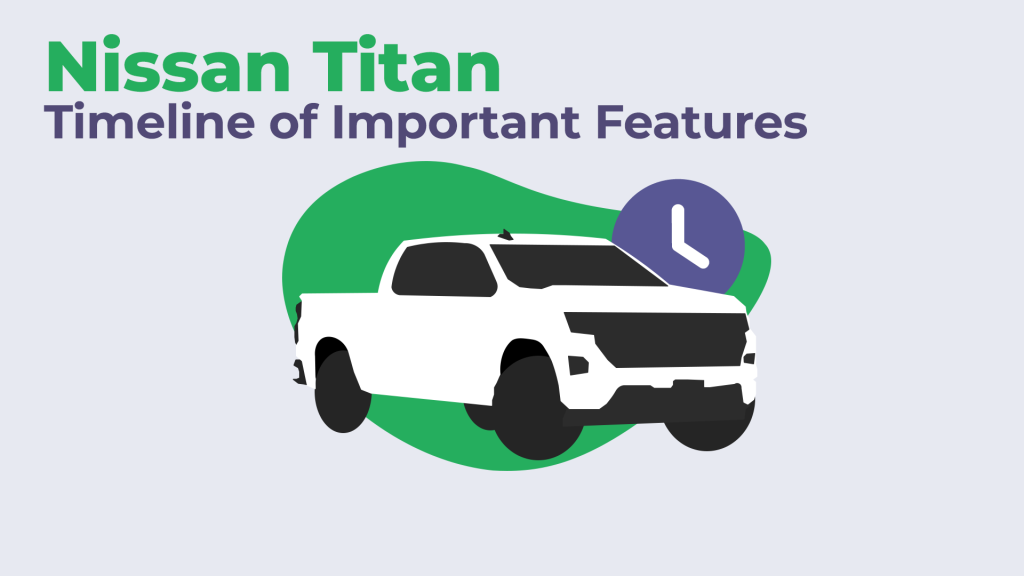
2004: Brand-new full-size truck released with V8 engine and spacious interior
2005: Standard front seat active head restraints and dampened tailgate assist
2006: Auto climate control system and power-folding mirrors with heat, power adjust, auto dim, and integrated turn signal
2007: V8 engine increases from 305 to 317 horsepower, LE and SE models add chrome packages
2008: Longer wheelbase available, Bluetooth hands-free phone system, 8.0 inch DVD player, revised front end and wheel moldings
2009: New Titan Heavy Metal Package introduced that includes chrome step rails and wheels
2010: Stability control, side airbags, and curtain airbags are now standard
2011: Trim levels renamed, SE becomes SV, LE becomes SL
2012: New Sport Appearance Package with 20-inch wheels and exterior and interior enhancements
2013: Rearview camera optional in some models, standard step rails on SV and SL
2014: Bluetooth microphone upgraded, relatively unchanged from the previous year
2015: Long wheel base no longer available, power adjustable lumbar support added to models with captains chairs
2016: Nissan did not produce a Titan this year
2017: Complete redesign for the Titan’s second generation. New DIG 5.6-liter Endurance V8 boasting 390 horsepower.
2018: Midnight Edition Package introduced on crew cab SL and SV trims
2019: New 7-inch infotainment system with NissanConnect, Apple CarPlay, and Android Auto
2020: 9-speed transmission replaces the previous 7-speed, V8 engine gets a slight power increase, bolder styling, and streamlined interior
2021: Unchanged from the previous year’s redesign
2022: 9-inch touchscreen display, dual zone HVAC, heated front seats, and leather-wrapped steering wheel become standard. SL trim dropped
The Best Years of the Nissan Titan
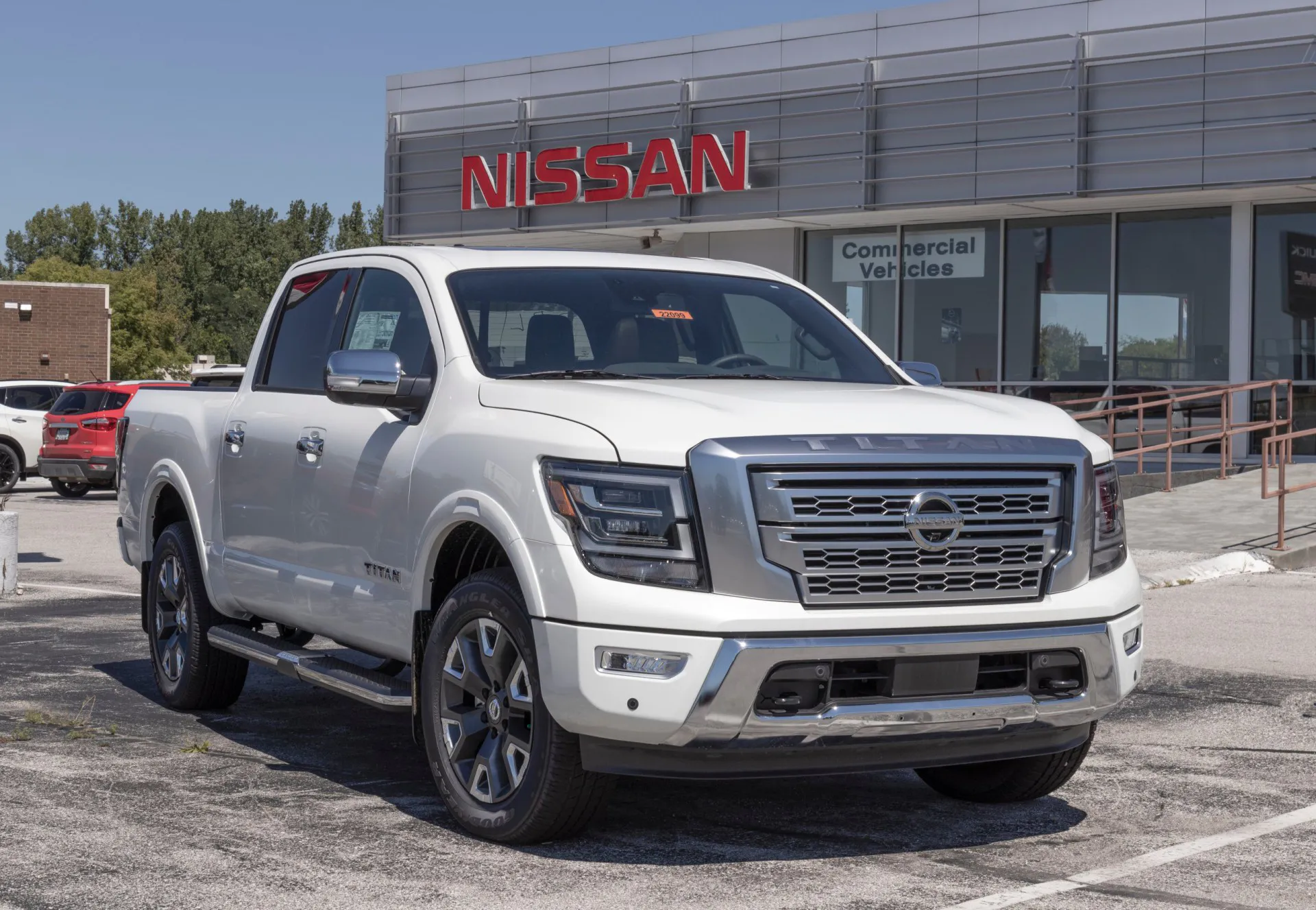
Ranking the Nissan Titan’s finest years, we’ve assessed each using the FIXD Reliability Score, Owner Reliability Score, safety ratings, and fuel economy. Additionally, we delve into crucial data on frequent DTCs and safety recall information
2017-2019 Nissan Titan
FIXD Reliability Score: 8-9/10
Owner Reliability Score: 6-10/10
KBB Value: $20,714-$26,225
Fuel Economy: 18 mpg
Annual Maintenance/Repair: $417-$679
Safety Rating: 4.4-4.8/5
2017-2019 Nissan Titan is the best and most reliable Titan. After a hiatus in 2016 when Nissan did not produce a Titan, the truck was back and better than ever for its second generation in 2017. In fact, the 2017 Titan won Truck Trend’s 2017 Pickup Truck of the Year. An upgraded 5.6-liter Endurance V8 increased power and fuel efficiency with Direct Injection Gas (DIG) technology. With a complete redesign from the first generation, the 2017-2019 Titan is a great truck that competes with other half-tons from GM, Ford, or Toyota.
2017 and 2019 Titan’s have an 8/10 FIXD Reliability Score, while 2018 has 9/10. This indicates a low number of engine-related DTCs are triggered in these years. However, the 2017 Titan is one of only two years where the Owner Reliability Score is lower than the FIXD Reliability Score, at only 6/10. Owners that gave 2017 a lower score might be experiencing issues unrelated to the engine.
The 2018 Titan has an average of 9/10 Owner Reliability Score, while the 2019 Titan has a perfect 10/10. 21% and 15% of owners believe these model years will exceed 200,000 miles.
The safety rating was highest in 2017 when the truck earned an average of 4.8 out of 5 stars. 2018-19 have 4.4/5 safety ratings, which is still great for a full-size pickup, but less than the average across the auto industry. These ratings are comparable to the best-selling truck in the United States, the Ford F-150. The F-150 scored an average of 4.75 in 2017, 4.8 in 2018, and 4.25 in 2019.
The repair costs for the 2017-2019 Nissan Titan are very reasonable, all below the average of $701 for all Titans. 2017 repair costs are $679, 2018 are $583, and 2019 are $417 annually.
A common DTC in the 2017 and 2019 Titan is P0025, which means “Camshaft Position B – Timing Over-Retarded – Bank 2.” The most common code in the 2019 Titan is P0022 (Intake Camshaft Position – Timing Over-Retarded – Bank 2). The most common fix in the Titan for both P0022 and P0025 is replacing the Camshaft Position Sensor, which costs between $56-$159. Another common code in the 2018 and 2019 model years is P0448 or Evaporative Emission Control System Vent Control Circuit Shorted. This is often just a loose or damaged gas cap, although it could be a charcoal canister. If it is the gas cap, it might only be $20-$60 to replace, or free if all it needs is tightened!
The 2017 Nissan Titan has three recalls, one investigation, and 98 complaints. 2018 Titan has four recalls, one investigation, and only 38 complaints. The 2019 Titan also fares great, with four recalls, no investigations, and 23 complaints. A recall all three years share is a potential alternator wiring harness short, which could result in a fire.
2013-2014 Nissan Titan
FIXD Reliability Score: 7-9/10
Owner Reliability Score: 8-10/10
KBB Value: $10,513-$11,845
Fuel Economy: 15 mpg(Gas), 10.5 mpg(E85)
Annual Maintenance/Repair: $625
Safety Rating: 3-4/5
The 2013-2014 Nissan Titan is the next best Titan, with excellent reliability scores and low repair costs. These years saw improved technology features, with 2013 gaining an optional rearview camera and 2014 improving Bluetooth technology and microphone. Equipped with a V8 engine producing 317 horsepower and a five-speed transmission, 2013-2014 delivered performance and towing ability.
The FIXD Reliability Score for the 2013 Titan is 7/10, while the 2014 Titan tied 2018 for the highest amongst all FIXD Reliability Scores, 9/10. The Owner Reliability Score for 2013 is a perfect 10/10, and 2014 gets the lower Owner Reliability Score at 8/10.
The safety ratings for the 2013-2014 Titan are among its weakest points. The 2013 Titan was rated 4/5, and the 2014 was rated a dismal 3/5. While these scores aren’t great, they aren’t much worse than the Toyota Tundra, rated 3.75 in 2013 and 3.5 in 2014.
Repair and maintenance costs are only $625 annually, less than average ($701). Both years have an average of 137,500 miles, which is reasonable for 9 and 10 years old. With a market value of just over $10K, the 2013-2014 Nissan Titan is a great truck to consider buying used.
The most common engine code for the 2013 Nissan Titan is P0442 (Evaporative emission control system leak – medium), which could be solved by one or more of the following repairs:
- Gas Cap $20-$60
- Evap Purge Volume Control Valve $150-$200
- Charcoal Canister Vent Control Valve $150-$200
- Replacement Evap Line $50-$100
- Charcoal Canister $200-$600.
The next most common engine light is caused by P0420 (Catalyst system efficiency below threshold – Bank 1), which is a bad catalytic converter ($1,538-$2,041). Last for 2013 is P0175, Bank 2 has too much fuel or insufficient air. This DTC is commonly caused by a bad oxygen sensor ($200-$300) or a dirty or bad mass airflow sensor ($172-$309).
The most common DTC for the 2014 Titan (P0101) is also a dirty or bad mass airflow sensor. P0101 means Mass Air Flow (MAF) Circuit/Performance Malfunction and costs between $172-$309 to repair or replace that part. The second place is P0456, which means a small evaporative emission control system leak. A loose gas cap usually causes P0456, but it could cost $20-$60 if it needs replacing. Third place in the 2014 model year is P0300 or random multiple misfires. Repair this CEL by replacing ignition coils ($230-$640), spark plugs ($66-$250), or both.
The 2013 Nissan Titan only has three recalls and eleven complaints. The 2014 Nissan Titan fares better, with two recalls and nine complaints. Recalls can be repaired for free by appointment with a Nissan dealer.
2009-2011 Nissan Titan
FIXD Reliability Score: 5-7/10
Owner Reliability Score: 7-10/10
KBB Value: $6,870-$9,448
Fuel Economy: 14-15 mpg(Gas), 11 mpg(E85)
Annual Maintenance/Repair: $250-$1,250
Safety Rating: 3-4/5
The last model year on our best list is the 2009-2011 Nissan Titan. 2009 saw the introduction of a Heavy Metal Package with chrome wheels and step bars. The 2010 Titan increased safety by making stability control, side airbags, and curtain airbags standard equipment. In 2011, the trims had a name change, dropping the SE and LE and adding SV and SL.
The FIXD Reliability Scores for 2009 (6/10), 2010 (7/10), and 2011 (5/10) Titans are above average but indicate an increase in DTCs for these model years. However, the Owner Reliability Score is 7/10 in 2009 and a perfect 10/10 in the 2010 and 2011 models.
Safety ratings are another chink in the armor, scoring a dreaded 3/5 in 2011 and a more reasonable 4/5 in 2009 and 2010. Another half-ton truck, the GMC Sierra 1500, gained a 4.5/5 rating in 2009-2011.
The major difference in these model years is the cost of repairs and maintenance. This figure is acquired through owners’ answers to the question, “How much would you say you spent on repairs and maintenance in 2022?” The 2009 and 2011 Titans have some of the best responses, averaging $250 and $375, respectively. The 2010 Titan is a different story, costing a whopping $1,250 for repairs annually. However, the truck is still one of the most reliable years of the Titan.
P0455, System Gross Leak Evaporative System Malfunction, is a common DTC in all three years. While the most common cause is a loose or damaged fuel cap, there is a possibility of other necessary repairs to extinguish the light;
- Gas Cap ($20-$60)
- EVAP Line ($20-$100)
- EVAP Vent Control Valve ($150-$200)
- Purge Volume Control Valve ($150-$200).
The 2009 and 2011 Titans also share code P0430, Catalyst system efficiency below threshold (Bank 2). The 2011 model year also reports engine light P0420 regularly, the same issue in bank 1. These codes are typically solved by replacing the catalytic converter, ranging from $1,538 to $2,041.
Another common code in the 2010 Titan is P0133, O2 Sensor Circuit Slow Response (Bank 1 Sensor 1). P0133’s most common cause is a faulty oxygen sensor, costing $200-$300 to replace. Lastly, the 2010 Titan commonly flashes P0300 or random multiple misfires. The potential repairs include:
- Spark plugs: ($66-$250)
- Ignition Coils: ($230-$640)
- Spark plug wires: ($180-$240)
- Fuel injectors: ($1500-$1900)
- Vacuum leak: ($100-$200)
- Fuel pump: ($1300-$1700)
- Fuel pressure regulator: ($200-$400).
The Titan isn’t known for numerous recalls, and the 2009 Nissan Titan continues that trend with four recalls and 39 complaints. The 2010 Titan has four recalls and 44 complaints. And lastly, the 2011 Nissan Titan is the best of the bunch, with only one recall and 24 complaints.
The Worst Years of the Nissan Titan
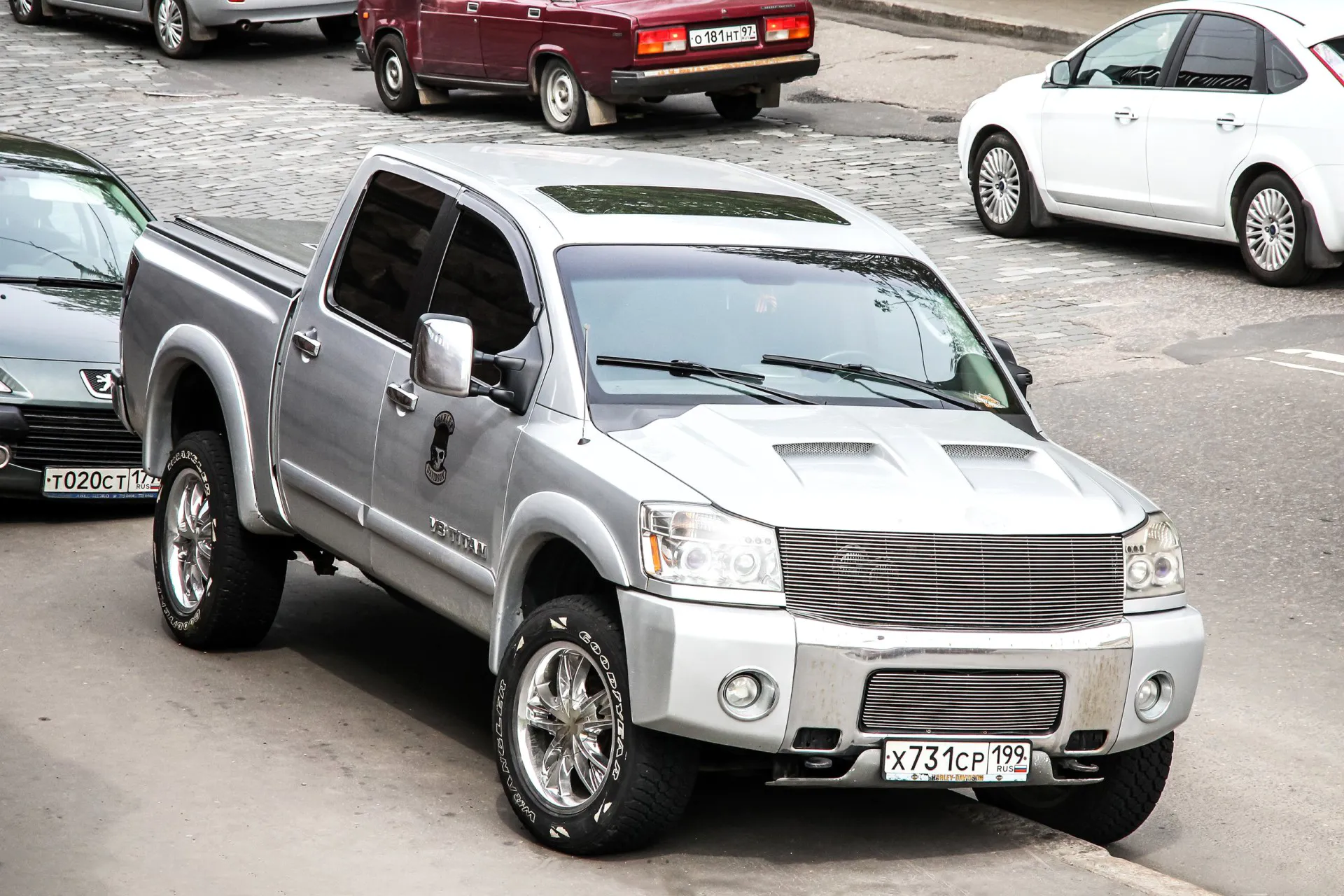
The Nissan Titans models we advise steering clear of are listed below, starting with the least favorable. We based our recommendations primarily on the FIXD Reliability Score and Owner Reliability Score. Safety ratings, miles per gallon, market value, repair costs, common DTCs, and safety recalls were also considered.
2015 Nissan Titan
FIXD Reliability Score: 1/10
Owner Reliability Score: 10/10
KBB Value: $18,574
Fuel Economy: 15 mpg(Gas), 11 mpg(E85)
Annual Maintenance/Repair: $750
Safety Rating: N/A
The 2015 Nissan Titan is the last year of the first generation. Besides dropping the long wheelbase option, 2015 only made minor changes before taking a hiatus next year.
The abysmal FIXD Reliability Score of 1/10 is the main reason the 2015 Titan is on the worst side of the list. It still manages to score a perfect 10/10 in the Owner Reliability Score.
We also recommend avoiding the 2015 Nissan Titan because of its incomplete safety rating. The NHTSA did not give the 2015 a rating.
The annual maintenance and repair cost isn’t outrageous at $750 but above the average of $701. 100% of owner responses said they paid for a repair over $500, and the biggest complaint of the year is that it is “expensive to repair.”
The most common DTC for the 2015 Nissan Titan is P0159, which means “Oxygen Sensor (Bank 2 Sensor 2).” If your Titan requires a new oxygen sensor to clear the code, it will cost $200-$300. P0448 (Evaporative Emission Control System Vent Control Circuit Shorted), is the second most common code in this model year, requiring a new charcoal canister and costing $753-$1,000. Rounding out the top three is P0456, the gas cap issue. If all it needs is tightened, it will be a free fix, but if you want a new one, it will cost between $20-$60.
The 2015 Nissan only has one recall related to the front airbags. The truck has nine complaints.
2004-2007 Nissan Titan
FIXD Reliability Score: 2-5/10
Owner Reliability Score: 6-8/10
KBB Value: $5,081-$6,514
Fuel Economy: 14 mpg(Gas), 10 mpg(E85)
Annual Maintenance/Repair: $667-$861
Safety Rating: 4-4.5/5
The Nissan Titan was first introduced in 2004 and was a popular truck competing directly with the likes of Ford, Chevrolet, GMC, and Toyota. With a 5.6-liter V8 engine, the Titan was focused on providing the consumer with great performance and towing ability. Frankly, the Nissan Titan has some of the best overall reliability scores, especially in the trucks we recommend avoiding.
The FIXD Reliability Score is 2/10 for the 2004 Titan, 5/10 for 2005, and 4/10 for 2006-2007. The Owner Reliability Score for The 2004 Titan is 8/10, 2005 and 2007 is 7/10, and 2006 received a score of 6/10.
The NHTSA didn’t give the 2004 model year a safety rating, but the 2005 Titan scored 4.5 out of 5 stars, one of only two years in the Titan was above the average across the automotive industry. The 2006-07 Titan earned 4 out of 5 stars. The Ford F-150 was given 4.5/5 stars in 2005-2007 but earned a perfect 5-star rating in 2004.
Annual costs of repair and maintenance aren’t terrible, but owner surveys tell us that 2004 ($861), 2005 ($857), and 2006 ($841) are all above the average of all Titans ($701). The 2007 Titan does better, only costing $667 yearly.
P0420 and P0430 are engine codes prevalent in all four years of the 2004-2007 Nissan Titan. These codes almost guarantee this Titan will need a catalytic converter replacement ($1,538-$2,041). The 2006 and 2007 Titans also share P0445, which is often triggered after a person fails to fully tighten their gas cap after fueling up.
Diagnostic trouble codes P0057 (H02S2 Heater Control Circuit Low (Bank 2, Sensor 2)) and P0133 (Intake Air Temperature (IAT) Sensor Circuit High Input Problem) are the final most common in these model years. You’ll likely have to replace a heated oxygen sensor ($153-$306) to fix P0057. A common cause for P0133 is a faulty or loose Intake Air Temperature Sensor, which costs $87-$96 to repair.
The 2004 Nissan Titan has seven recalls and an astounding 1,040 complaints. The 2005 Titan has six recalls, one investigation, and 886 complaints. 2006 Nissan Titan has another seven recalls, one investigation, and 425 complaints, while the 2007 Titan has two recalls and 136 complaints.
2008 Nissan Titan
FIXD Reliability Score: 4/10
Owner Reliability Score: 8/10
KBB Value: $7,063
Fuel Economy: 14 mpg(Gas), 10 mpg(E85)
Annual Maintenance/Repair: $938
Safety Rating: 4/5
The 2008 model was a mid-generation facelift for the Nissan Titan, so we separated it from 2004-2007. While the update brought some exterior styling and technology upgrades, they still pack enough punch to get this year on the best side of the list. The 2008 Nissan also introduced a longer wheelbase.
The FIXD Reliability Score is almost average, at 4/10. The Owner Reliability Score is 8/10, meaning customers are happy with their Titan regardless of the higher number of engine-related DTCs.
The safety rating for 2008 falls in line with other Titans, at 4 out of 5 stars. America’s best-selling truck, the Ford F-150, received 4.5 stars in 2008.
The high repair and maintenance cost of the 2008 Titan is another reason to avoid this truck. While the average is $701, 2008’s annual maintenance will run over $200 more than that, at $938. Additionally, 86% of owners answered they had a $500+ repair in 2022, and 28.57% of those repairs were related to the A/C or heat.
The most common diagnostic trouble code in the 2008 Titan is P0462, Fuel level Sensor Circuit Low Input. The most common fix for P0462 is replacing a battery cable terminal ($57-$491). Second place is P0455, System Gross Leak Evaporative System Malfunction. The most common cause of the DTC P0455 is a loose gas cap; tightening it won’t cost a penny. Last but not least, the 2008 Titan reported a large number of P0430, which means there is a good chance the catalytic converter ($1,538-$2,041) needs to be replaced in this model year.
The 2008 Nissan Titan has six recalls and 128 complaints.
FAQs
What years of the Nissan Titan have engine and/or transmission problems?
Overall, the Nissan Titan has a reliable engine transmission with minimum problems. However, the 2004-2008 Titan has many DTCs related to the catalytic converter, which is a job affecting the truck’s engine. Also, in 2005 and 2007, the chance of a repair over $500 is 75%, with 25% of those repairs being engine-related.
On the other hand, 12.5% of the reported $500+ repairs in 2004-05 is a transmission repair. Additionally, the 2004-2006 Titan has had many complaints over the years, most of which are about the powertrain. For example, 469 out of the 886 complaints about the 2005 Titan are powertrain related, with owners reporting the transmission not shifting.
What is considered high mileage for a Nissan Titan?
According to our data and sources, the average miles on a Nissan Titan is 127,180. The highest average mileage belongs to the 2005 Titan at 203,571 miles, while the lowest we have adequate data for is 58,333 on the 2019 model. Therefore, anything above 153,571 could be considered high mileage.
Categorizing a vehicle as having high mileage is also relative to its age. The average number of miles driven each year is 12,000. So, a four-year-old Titan with 96,000 miles would be considered extremely high, while an eight-year-old truck with the same mileage would be considered average.
Every Nissan Titan warrants individual attention, prompting us to suggest a thorough inspection to assess the impact of the miles driven on your specific vehicle or any potential Titan you may be considering.
What other vehicles should I consider?
If you’re considering a used Nissan Titan, look at the Chevrolet Silverado 1500. The Silverado offers a great alternative with its reliable performance and spacious interior. Another excellent choice to consider is the Toyota Tundra. Renowned for its durability and impressive towing capacity, the Tundra offers a dependable and rugged option for your truck requirements.
If you want a truck with a long-standing reputation, you should take a look at the Ford F-150. As one of the best-selling trucks in the market, the F-150 boasts a wide range of configurations and features to suit your preferences. Lastly, don’t overlook the GMC Sierra 1500 in your search. With its upscale interior and capable performance, the Sierra 1500 provides a solid alternative to the Nissan Titan, ensuring you have multiple choices to consider before deciding.
What owners of the Nissan Titan like to use their car for:
Nissan Titan owners were asked, “What do you use your car for?” Most people use their Titan as a family vehicle at 32%. A close second place is hauling/towing at 28%, and the third place is for lots of driving (travel/long commute) at 21%. 12% reported using their truck for outdoor/off-road use. The lowest documented uses were for luxurious driving (4%), as an office on wheels (2%), and for sport/fast driving (1%).
| Frequent Use Categories: | How Useful? (Out of 5 Stars) |
| Family Vehicle | **** |
| Lots of Driving (travel/long commute) | *** |
| Hauling/Towing | *** |
| Office on Wheels | * |
| Sport/Fast Driving | * |
| Luxurious Driving | * |
| Outdoor/Off-Road | ** |
A Note About Data and Information Sources
This article has many details about Nissan Titan’s reliability; here’s what we used for our assumptions and recommendations.
- FIXD Reliability Score & Data: Engine reliability information is captured via the FIXD App.
The FIXD Reliability Score is calculated using the number of DTCs per year, weighted by mileage. This is then turned into a scale of 1-10 for easy graphing.
This is an objective score.
- Owner Reliability Score & Data: This data is the result of surveying Nissan Titan owners who use FIXD.
The Owner Reliability Score comes straight from owners of the Nissan Titan.
This is a subjective score.
To determine the Owner Reliability Score we ask each car owner:
How reliable would you say your Nissan Titan is?
a. Just point A to point B driving
b. A Daily Commuter
c. Good for a 100 mile road trip
d. Good for a 500 mile road trip
e. I could take a cross-country road trip, no problem
From here we translate their answers into the Owner Reliability Score:
a. = 2
b. = 4
c. = 6
d. = 8
e. = 10
Keep in mind, owners may think their car is more or less reliable than it actually is.
One potential problem is that people often buy the same make or model they are used to when they go car shopping, just a newer year.
Ford, for instance, has a number of consumer loyalty awards for the Ford F-Series, Ford Mustang, and Ford Expedition.
Car owners may be so loyal to the make or model they currently own that they would have trouble accurately comparing their cars’ reliability to others.
It’s for this reason that we ask car owners a question that is relative to mileage rather than relative to other cars.
Still, be mindful of the accuracy of these Owner Reliability Scores, people’s perceptions and unconscious blindspots can skew data.
We suggest looking at both the FIXD Reliability Score and the Owner Reliability Score for this reason.
- KBB Value: Average private-seller valuations as supplied by Kelley Blue Book (KBB), based on a Nissan Titan with typical mileage for that respective model year.
- Fuel Economy: Mileage-per-gallon estimates according to the EPA MPG on Fueleconomy.gov
- Annual Maintenance/Repair: Upkeep expenses as reported by surveyed Nissan Titan owners
- Safety Rating: Crash test data collected and reported by NHTSA. We average all ratings for each year to come up with a simplified, average safety score. This makes it easier to look at on a graph.
References
- Nissan Titan model-specific information, edmunds.com (various dates). Retrieved July 25, 2023, from https://www.edmunds.com/
- Model-specific recall information as per the National Highway Transportation Safety Administration. Retrieved July 25, 2023, from https://www.nhtsa.gov/recalls
- Nissan Titan Generations, carbuzz.com. Retrieved July 25, 2023, from https://carbuzz.com/cars/nissan/titan-generations
- Nissan TITAN named TRUCK TREND’s 2017 Pickup Truck of the Year, usa.nissannews.com, January 8, 2017. Retrieved July 25, 2023, from https://usa.nissannews.com/en-US/releases/release-c1e432741a2f448c8615d0e05f26825a-nissan-titan-named-truck-trend-s-2017-pickup-truck-of-the-year?selectedTabId=releases
- Nissan Titan model-specific information, usa.nissannews.com (various dates). Retrieved July 25, 2023, from https://usa.nissannews.com/en-US
- P0025 OBD-II Trouble Code: Camshaft Position B – Timing Over-Retarded (Bank 2), yourmechanic.com. Retrieved July 25, 2023, from https://www.yourmechanic.com/article/p0025-obd-ii-trouble-code-camshaft-position-b-timing-over-retarded-bank-2-by-jay-safford
- P0159 OBD-II Trouble Code: Oxygen Sensor (Bank 2 Sensor 2), yourmechanic.com. Retrieved July 25, 2023, from https://www.yourmechanic.com/article/p0159-obd-ii-trouble-code-oxygen-sensor-bank-2-sensor-2-by-robert-kulp
- P0448 OBD-II Trouble Code: Evaporative Emission Control System Vent Control Circuit Shorted, yourmechanic.com. Retrieved July 25, 2023, from https://www.yourmechanic.com/article/p0448-obd-ii-trouble-code-evaporative-emission-control-system-vent-control-circuit-shorted-by-valerie-johnston
- P0462 OBD-II Trouble Code: Fuel level Sensor Circuit Low Input, yourmechanic.com. Retrieved July 25, 2023, from https://www.yourmechanic.com/article/p0462-obd-ii-trouble-code-fuel-level-sensor-circuit-low-input-by-valerie-johnston

Keith Rollins is a copywriter and author that has been involved in the automotive industry for over 12 years. He has written for hotcars.com and is featured on Copywriting.org. When he’s not writing he’s spending time with his three kids, hiking, working on cars, or running. You can see his work at keithrrollins.com.

